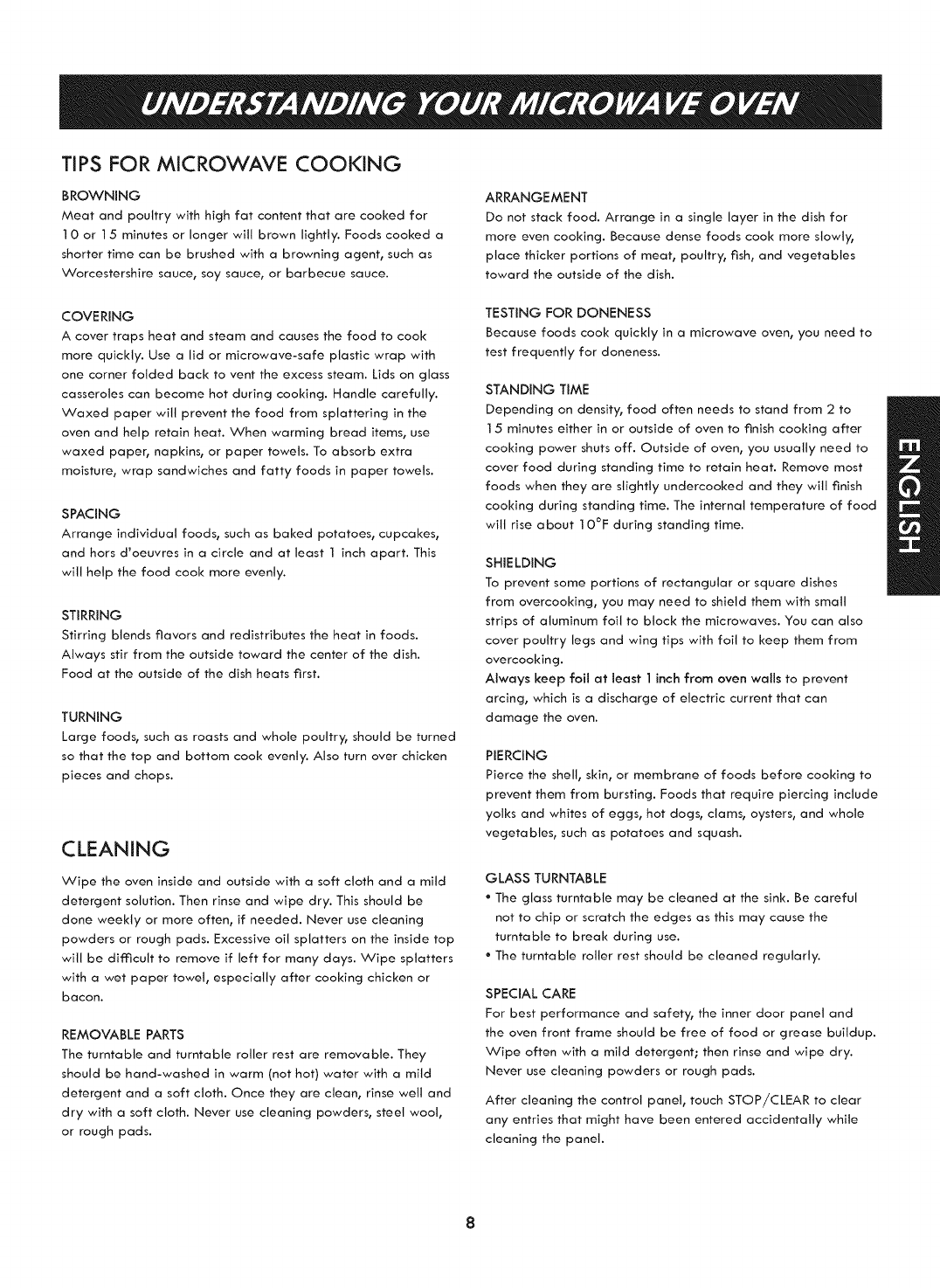
TiPS FOR MICROWAVE COOKING
BROWNING
Meat and poultry with high fat content that are cooked for
10 or 15 minutes or longer wilt brown lightly. Foods cooked a
shorter time can be brushed with a browning agent, such as
Worcestershire sauce, soy sauce, or barbecue sauce.
ARRANGEMENT
Do not stack food. Arrange in a single layer in the dish for
more even cooking. Because dense foods cook more slowly,
place thicker portions of meat, poultry, fish, and vegetables
toward the outside of the dish.
COVERING
A cover traps heat and steam and causes the food to cook
more quickly. Use a lid or microwave-safe plastic wrap with
one corner folded back to vent the excess steam. Lids on glass
casseroles can become hot during cooking. Handle carefully.
Waxed paper will prevent the food from splattering in the
oven and help retain heat. When warming bread items, use
waxed paper, napkins, or paper towels. To absorb extra
moisture, wrap sandwiches and fatty foods in paper towels.
SPACING
Arrange individual foods, such as baked potatoes, cupcakes,
and hors d'oeuvres in a circle and at least 1 inch apart. This
wilt help the food cook more evenly.
STiRRiNG
Stirring blends flavors and redistributes the heat in foods.
Always stir from the outside toward the center of the dish.
Food at the outside of the dish heats first.
TURNING
Large foods, such as roasts and whole poultry, should be turned
so that the top and bottom cook evenly. Also turn over chicken
pieces and chops.
CLEANING
Wipe the oven inside and outside with a soft cloth and a mild
detergent solution. Then rinse and wipe dry. This should be
done weekly or more often, if needed. Never use cleaning
powders or rough pads. Excessive oil splatters on the inside top
will be dimcult to remove if left for many days. Wipe splatters
with a wet paper towel, especially after cooking chicken or
bacon.
REMOVABLE PARTS
The turntable and turntable roller rest are removable. They
should be hand-washed in warm (not hot) water with a mild
detergent and a soft cloth. Once they are clean, rinse well and
dry with a soft cloth. Never use cleaning powders, steel wool,
or rough pads.
TESTING FOR DONENESS
Because foods cook quickly in a microwave oven, you need to
test frequently for doneness.
STANDING TiME
Depending on density, food often needs to stand from 2 to
1 5 minutes either in or outside of oven to finish cooking after
cooking power shuts off. Outside of oven, you usually need to
cover food during standing time to retain heat. Remove most
foods when they are slightly undercooked and they wilt finish
cooking during standing time. The internal temperature of food
wilt rise about 10°F during standing time.
SHiELDiNG
To prevent some portions of rectangular or square dishes
from overcooking, you may need to shield them with small
strips of aluminum foil to block the microwaves. You can also
cover poultry legs and wing tips with foil to keep them from
overcooking.
Always keep foil at least 1 inch from oven walls to prevent
arcing, which is a discharge of electric current that can
damage the oven.
PiERCiNG
Pierce the shell, skin, or membrane of foods before cooking to
prevent them from bursting. Foods that require piercing include
yolks and whites of eggs, hot dogs, clams, oysters, and whole
vegetables, such as potatoes and squash.
GLASS TURNTABLE
• The glass turntable may be cleaned at the sink. Be careful
not to chip or scratch the edges as this may cause the
turntable to break during use.
• The turntable roller rest should be cleaned regularly.
SPECIAL CARE
For best performance and safety, the inner door panel and
the oven front frame should be free of food or grease buildup.
Wipe often with a mild detergent; then rinse and wipe dry.
Never use cleaning powders or rough pads.
After cleaning the control panel, touch STOP/CLEAR to clear
any entries that might have been entered accidentally while
cleaning the panel.
8


















